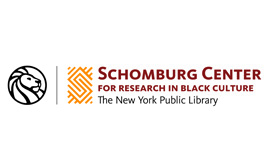Schomburg Center for Research in Black Culture New York, New York, United States
The Schomburg Center for Research in Black Culture of The New York Public Library is one of the world's leading research facilities devoted to the preservation of materials on the global African and African diasporan experiences. A focal point of Harlem's cultural life, the Center also functions as the national research library in the field, providing free access to its wide-ranging noncirculating collections. It also sponsors programs and events that illuminate and illustrate the richness of black history and culture.
In 1926 the personal collection of the distinguished black scholar and bibliophile Arturo Alfonso Schomburg was purchased by The New York Public Library for the Division of Negro Literature, History and Prints of the 135th Street Branch. Schomburg served as curator of the division from 1932 until his death in 1938. In 1972 the center was designated as one of the Research Libraries of The New York Public Library.
From 10,000 items in 1926 the collections have grown to over 10 million items today, preserved in five divisions: the Jean Blackwell Hutson Research and Reference Division, the Art and Artifacts Division, the Manuscripts, Archives and Rare Books Division, the Moving Image and Recording Sound Division, and the Photographs and Prints Division.
The Schomburg Center’s rare books collection include slavery and anti-slavery works from the United States and Europe and travel narratives in the Americas and Africa. Documents from the United States, Argentina, Brazil, Cuba and Haiti—including correspondence from Toussaint Louverture—and The Nautilus Insurance Company Slavery Era Ledgers form part of the manuscripts collections. Abolitionist pamphlets by African Americans are largely represented.
The Art and Artifacts collection include nineteenth century lithographs and engravings depicting Africans and people of African descent in the Americas. The collection of artifacts includes a wide range of two- and three-dimensional objects, such as slave shackles, medallions, and commemorative coins.
The Photographs and Prints collections of lithographs, engravings and original photographs cover the transatlantic slave trade; the trans-Saharan trade; slavery in the US and parts of the Caribbean; the US abolition movement and the US Civil War. Images consist of portraits, views, diagrams and metaphorical images. The abolitionist items focus on African American abolitionists. Some items pertain to the Caribbean abolition; others portray Africans in Europe during the 18th and 19th centuries.
The Schomburg Center is home to the Lapidus Center for the Historical Analysis of Transatlantic Slavery—funded by a generous $2.5 million gift from Ruth and Sid Lapidus matched by The New York Public Library—is the only facility of its kind based in a public research library. The Center's mission is to generate and disseminate scholarly knowledge on the slave trade, slavery, and anti-slavery pertaining to the Atlantic World. The Lapidus Center supports the work of researchers with long-term and short-term fellowships. Given the centrality of Atlantic slavery to the making of the modern world, the Lapidus fellowships ensure that slavery studies are a cornerstone of the Schomburg Center’s broader research community and provide a counterbalance to the contemporary direction of scholarship in African American and African Diaspora studies. To raise awareness and historical literacy, the Lapidus Center engages the public with a variety of programs, an annual nonfiction prize, exhibitions, conferences, and partnerships with local, national, and international institutions.
The Schomburg Center also has an active exhibitions program featuring art objects, photographs, documents, published works and artifacts drawn from its own holdings, as well as resources from other institutions. These exhibitions explore issues and themes in the history and culture of people of African descent throughout the world. Online exhibitions, drawing mostly from the Center’s collections, offer interpretative essays, images, maps, multimedia, and books to a global audience.
Related Topics:
Related Pages:
-
 Haiti (Saint-Domingue)
Haiti (Saint-Domingue)
-
 Atlantic Free Black Communities
Atlantic Free Black Communities
-
 African Diaspora Culture
African Diaspora Culture
-
 John Kizell
John Kizell
-
 New Orleans, Louisiana
New Orleans, Louisiana
-
 Omar ibn Said
Omar ibn Said


